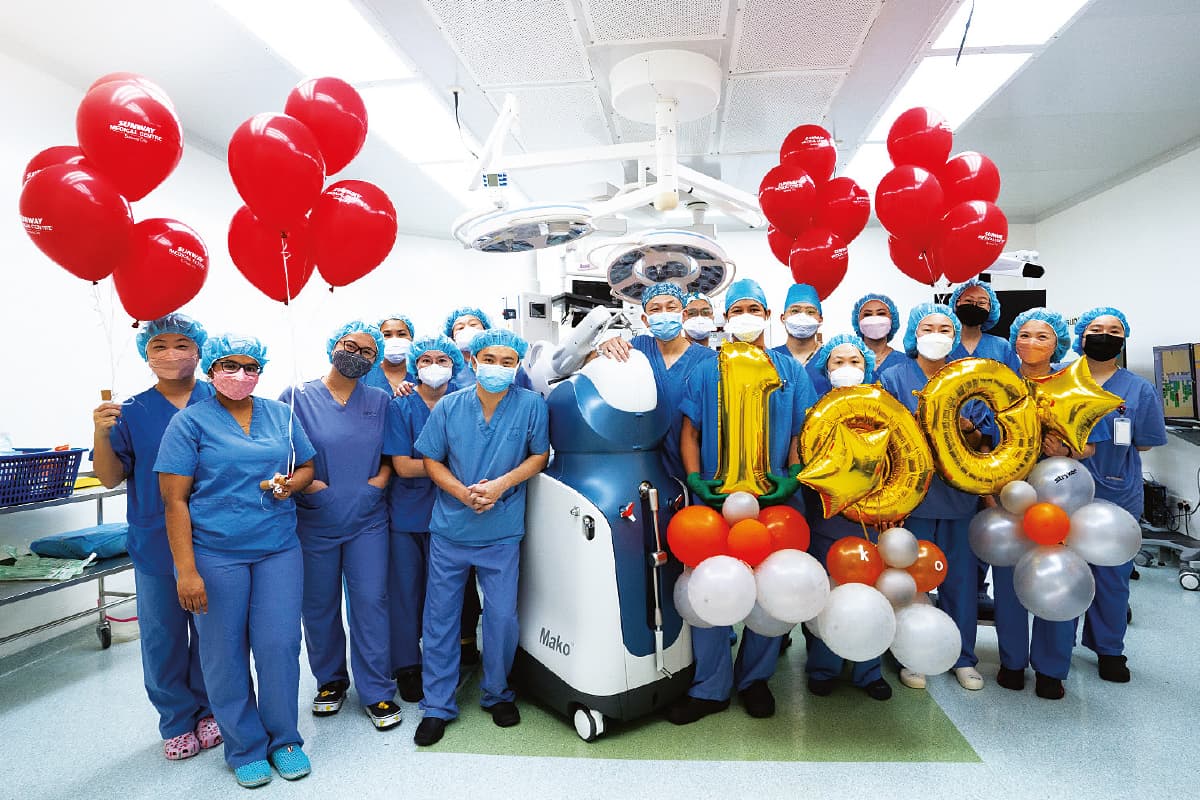

Hip & knee replacement surgery has brought new hope to countless people who have suffered from chronic joint pain, allowing them to say goodbye to their pain and restore mobility. As a hospital who understands the need for more precise surgical processes that improve patient outcomes and reduce recovery time, Sunway Medical Centre acquired the first robotic arm systems in Malaysia to assist in hip & knee replacement surgeries.
Dr Chua Hwa Sen, Consultant Orthopaedic, Joint and Arthroplasty Surgeon at Sunway Medical Centre successfully performed Malaysia’s first robotic arm total hip replacement using the Mako SmartRobotics in July 2021. Since then, he has also become the first single-surgeon in Malaysia to have performed 100 cases of robotic assisted joint replacements for his patients, many of whom he says no longer need walking-aids 14 days post-surgery.
The Anatomy of Hip & Knee Replacements
Hip replacements can be divided into total or partial hip replacements, while knee replacements are divided into total and partial knee replacements.
Dr Chua pointed out that artificial joint replacement has been used in the medical world for over 50 to 60 years. It involves replacing a damaged or non-functional joint with an artificial joint to treat conditions such as joint pain, deformity and restricted mobility, and is commonly used for hip and knee joints.
In a conventional joint replacement, the surgeon will rely on their own vision and experience to determine where to remove the joint and place the artificial joint, etc. The accuracy of the surgery is closely related to the surgeon’s experience and skill.
“In any case, the success rate of conventional hip & knee replacement surgery is quite high, with up to 96% of people being able to reclaim their mobility after completing artificial hip and knee replacements. However, of this 96% only 80% are considered very successful. About 16% of patients, although they can reclaim their mobility, they might not be able to walk very naturally and comfortably.”
Precision that Improves Patient Outcomes
What it means to consider the outcome of a hip or knee replacement as very successful, is that the implanted joint is comfortable and natural to use, with no pain at all. This is why the medical profession, in its quest for excellence, has revolutionised artificial joint replacement surgery with the introduction of robotic arm assisted surgeries.
“The biggest concern, especially after a conventional hip surgery, is dislocation. If the precision is improved, the chance of dislocation is also minimised,” says Dr Chua. The angular error of this robotic arm surgery is only 0.5 degrees or 0.75mm, achieving the most ideal artificial joint placement.
“Compared to conventional hip & knee replacement surgery, which requires a hospital stay of five days to a week, those treated with this new technology can be discharged much sooner while needing much less pain reliefs.”
It also greatly improves the durability of the artificial joint, where patients are able to make natural movements without feeling like there is an implant in their joints, resulting in a ‘natural joint’ effect that is not too tight or too loose in flexion, making you forget that you are using an artificial joint.
Benefits Outweigh Concerns in Robotic Joint Replacement Surgery
One concern from Dr Chua’s patients is usually, “Who is suitable for robotic hip & knee replacement surgery?”
He pointed out that anyone who is suitable for conventional hip & knee replacement surgery is suitable for robotic hip & knee replacement surgery.
“Hip & knee replacement surgery is needed when your joints are damaged & painful to the point of affecting your daily life, limiting your activities and reducing your quality of life. If your health is confirmed by your doctor as being able to afford the risks of surgery, then you may undergo the robotic hip & knee replacement surgery.”
The procedure is not suitable for people who cannot afford the risk of anaesthetic drugs and who have had a very serious bacterial infection in the joint. It is also not suitable for people with severe damage to the spine, weakness in the legs and insufficient muscle strength to support the artificial joint.
Making Robotic Hip & Knee Replacement Surgery Accessible
Despite the high cost needed, Sunway Medical Centre has decided to go ahead and invest in this new technology so that patients can reap the maximum benefit from these surgeries.
Dr Chua is confident that, based on the positive data and benefits currently being collected worldwide, robotic hip & knee replacement surgery will one day replace the conventional one. “The clinical data received from this procedure over the years has been very positive and we hope to introduce it to Malaysia so that local patients can get better results as well.”

